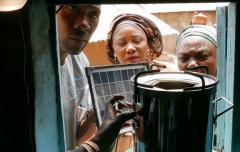Rift Valley Energy powers economic development with rural electricity network in Tanzania
Tanzania’s Mufindi district, in the country’s southern highlands, is an agricultural hotbed with sprawling tea plantations and grain fields. It is also becoming a shining example of how affordable, reliable, sustainable and modern energy is essential to growing economic activities and contributing to local development.
In 2008, the Rift Valley Corporation, which owned a tea farm in the district, recognized that intermittency in electricity supply from the national grid was causing business disruptions – not only for them, but for many other local businesses as well.
Taking matters into their hands, the company established Rift Valley Energy, which was responsible for developing a 4-megawatt hydro-power station that could provide electricity to the parent company’s operations and local businesses and households, with any excess being fed into the national grid.
“Our business is based on the ABC model,” explains Franz Kottulinsky, Co-Founder of Rift Valley Energy. “Projects are conceived based on their ability to primarily serve anchor customers, such as TANESCO, the national utility, then other businesses or industrial operations, and then communities.”
Following this model allowed the company to earn the support of the European Union and the Rural Energy Agency in financing the Mwenga Hydro and Rural Electrification Project. To secure this financing, Rift Valley Energy committed to building a rural electricity network. A backbone connection to the national grid located 70 kilometres away was built with dozens of branches to connect villages situated between the hydro project and national grid.
The project was commissioned in 2012 and to date the Mwenga rural distribution network totals more than 450 kilometres of power lines and serves 32 villages with a total of 4,700 connections (incl. households, small- and medium-sized enterprises and village institutions). Major agricultural businesses such as the Mufindi Tea Company and Unilever were also connected, using Rift Valley Energy’s electricity as a backup supply during outages to the national grid. Three hospitals, 20 health stations and 35 schools also now receive electricity from Rift Valley Energy.
Finally, any electricity not used by the rural network is fed into national grid based on a Standardized Power Purchasing Agreement (SPPA) of approximately 18 gigawatt hours per year, helping support grid stabilization.
Recognizing the impact of its initial project, Rift Valley Energy has since expanded its network operations deeper into the Mufindi district, it has built another hydro-based network in the Njombe region and is currently building another in Rungwe district. However, the company is also harnessing another renewable technology to improve the reliability of its original Mwenga project.
In June 2020, the first wind turbines starting spinning at the company’s 2.4-megawatt wind farm near Usokami Village in the Mwenga/Kihansi area. Kottulinsky says the company developed the wind farm to support its rural electricity supply during the dry season, when the generation capacity of the existing hydro facility is naturally low and when winds are strong in the project region. With increasing consumption from its customers, the wind farm feeds exclusively into the rural network, alleviating supply shortages.
“This is not only the first wind project in the country but also the first hydro- and wind-fuelled rural network in Tanzania,” Kottulinsky proclaims. “Integrating wind capacity into our network makes it far more reliable for our customers. We can now devote our hydro capacity to baseload supply for industry and businesses, allowing them to improve and grow their operations, and the added capacity also means we can further expand our rural network”.
The wind farm is expected to receive regulatory and utility approval in the next couple of weeks. Kottulinsky says that the company’s aim is to connect an anticipated 1,500 more customers to the Mwenga hydro-wind network over the next two years, including several new businesses, such as saw-, and maize milling centres, carpentry and welding workshops, and water pump stations. The company is already working with these businesses to retrofit their operations with efficient appliances that will maximize the productive use of Rift Valley Energy’s electricity.
“We hope that our electricity continues to be a catalyst for new businesses, jobs and improved livelihoods throughout the southern highlands of Tanzania,” says Kottulinksy.




